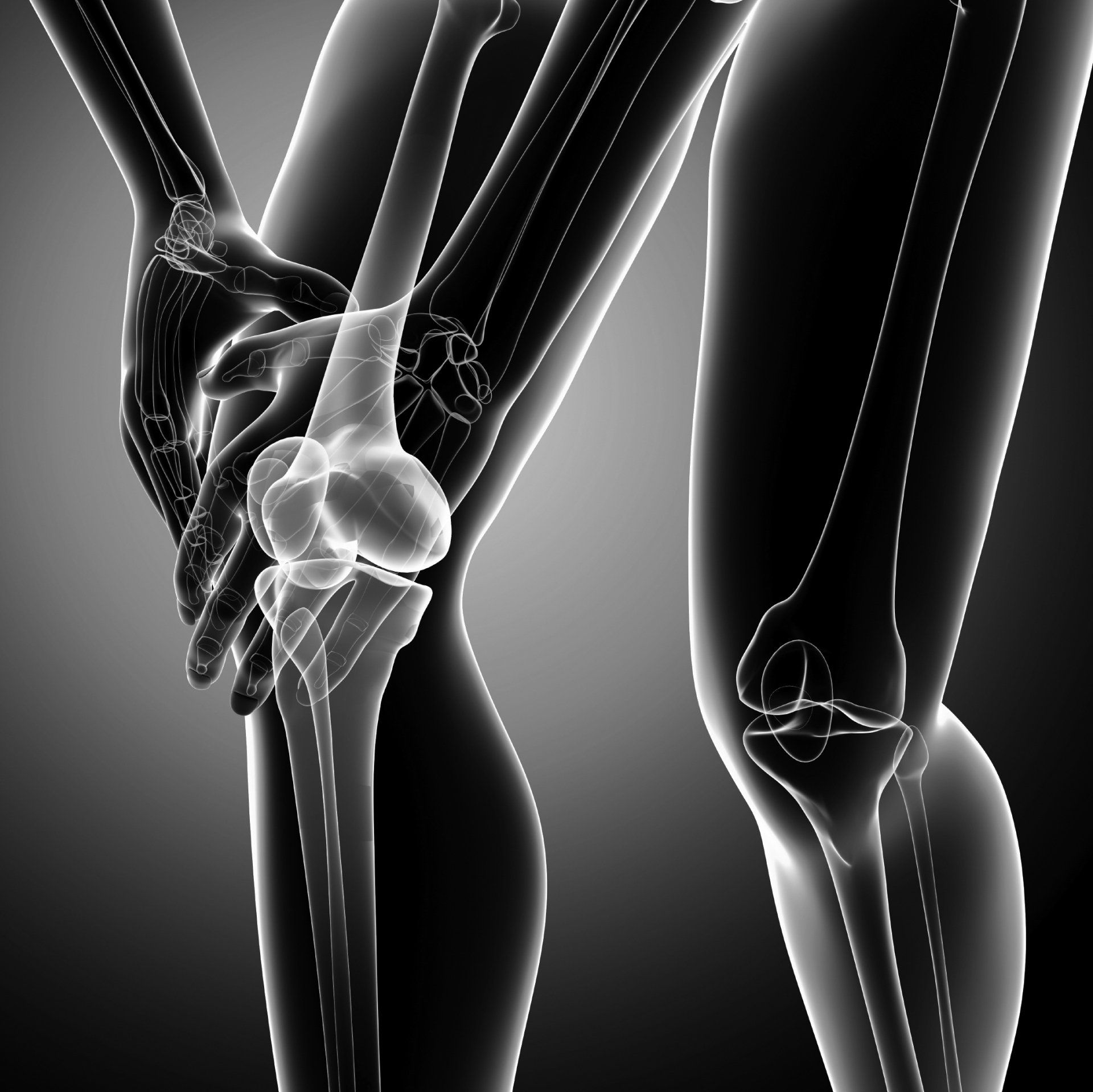Understanding Knee Replacement
According to the Centers for Disease Control, there are more than 500,000 total knee replacements performed each year in the United States. The surgery has more than a 90 percent patient satisfaction rate – with the majority of patients experiencing pain relief and improved mobility.
-
When to Consider Surgery
When arthritis in a joint becomes severe, the smooth cartilage surface covering the bones wears away and results in bone rubbing on bone. Further deterioration can cause chronic pain and deformity of the bone and joint. Patients with severe arthritis may want to consider joint replacement if they experience:
- Unrelieved pain after six to 12 months of conservative treatment
- Symptoms that significantly affect their ability to perform normal activities
- Pain that regularly interferes with sleep
- Pain and loss of mobility that greatly affect quality of life
-
Conservative Treatment Options
For patients with arthritis pain, conservative treatments such as anti-inflammatory medications, steroid injections and the use of a cane may become ineffective in controlling discomfort. Knee replacement surgery is considered when a patient does not respond to these nonsurgical treatments.
-
The Procedure
The knee is comprised of three joint compartments — medial, lateral and patellofemoral — which can be affected by osteoarthritis. Minimally invasive techniques are commonly employed in knee replacement surgery. Total knee replacement involves the surgical removal of the arthritic bone in all three joint compartments and the insertion of a metal and plastic or a ceramic, metal and plastic joint. Historically, total knee replacement results in more than a 90 percent patient satisfaction rate. With advancements in surgical techniques and instruments, the procedure can now be completed using minimally invasive techniques that allow the surgeon to work through an incision only four to five inches in length.
A small percentage of patients whose arthritis is severe and confined to a particular side of the knee joint may be candidates for minimally invasive partial knee replacement. Unlike total knee replacement surgery, which replaces all three compartments of the knee, partial knee replacement surgery replaces only a portion of the knee joint.
Based on your medical history, your physician will determine which procedure is most likely to work best and will provide information on what to expect from surgery.
-
Advantages of the Procedure
Compared with traditional knee replacement, minimally invasive surgery often results in less trauma to the soft tissues surrounding the knee, decreased blood loss, fewer complications, a shorter hospital stay, accelerated rehabilitation, better joint motion and a quicker recovery. Minimally invasive knee replacement is designed to help you return to your favorite activities faster.
-
Possible Complications
Although rare, the most common complications associated with total joint replacement are infection, blood clots and dislocation of your new joint. Because prompt attention is needed if complications arise, call our office at 1-866-874-7483 if you:
- Develop a persistent fever
- Have any drainage from the incision
- Experience increasing pain, swelling or redness, or have calf cramping
Report immediately to the emergency room if you experience shortness of breath, chest pain or coughing of blood. Some insurance providers require patients to contact their primary care physician before an emergency department visit. Follow your plan's guidelines.
-
Activities of Daily Living
In order to return to your normal activities sooner, you will need to practice your exercises regularly to regain strength and range of motion. The goal of your physical therapy is to strengthen the thigh muscles, which decreases the pressure on the joint, and to increase your joint flexibility, which prevents the new joint from stiffening.
While healing, you must protect your knee by modifying your daily activities. Do not twist your knee or engage in high-impact activities including running, jumping or playing sports. Movements such as these put additional strain on your new knee joint and can cause the implant to wear out faster. By avoiding these movements, you will better protect your new knee.
-
Things to Remember
Following total joint replacement, patients typically experience dramatic reduction in pain and stiffness, and often find they can do things they have not done in years. Enjoying the benefits of joint replacement will require one minor change in your lifestyle. You must inform your dentist and other physicians of your replacement to obtain preventive antibiotics prior to certain invasive medical procedures, including:
- Dental procedures, including routine cleanings
- Bronchoscopy
- Barium enema
- Colonoscopy
- Liver biopsy
- Tonsillectomy
- Urinary procedures
Steps related to Surgery
-
Step 1: Preparing for Surgery
Prior to your joint replacement surgery, you will need the following:
Medical clearance. Medical clearance lets your orthopedic surgeon know that you are in your best possible condition to undergo surgery and that there are no known correctable medical risks that may affect the outcome of your surgery. Your primary care physician can provide the appropriate medical clearance. If you are treated by a cardiologist or another specialist, you may need clearance from that physician as well.
Preoperative testing. One week prior to surgery, you will need to have some routine blood tests completed. Please be aware of your insurance provider’s policies as to where the tests must be performed. Some insurers require you to coordinate the tests through your primary care physician’s office or insist that specific labs be used for testing.
Surgery date. While in our office, you and your physician can decide on a mutually acceptable surgery date. The hospital will contact you the day before surgery to let you know what time to arrive the day of surgery and to get information for your medical records. If you do not receive a call from the hospital by 3 p.m. the day prior to surgery, please call our office at 1-866-874-7483.
-
Step 2: Arriving at the Hospital
On the day of your surgery, you will be admitted through the hospital’s information/admissions office. Prior to surgery you will meet with the preoperative nursing team. The team will check your blood pressure, take your pulse and perform other minor tests. You will also meet with the anesthesiologist to discuss the type of anesthesia you will receive.
Your surgeon may work with the anesthesiologist to manage your postoperative pain through multimodal pain management techniques, including prescription medications and nerve blocks. These help patients start their rehabilitation sooner, allowing for a faster recovery and a shorter hospital stay.
Your family may remain with you in a private room while you wait for surgery. Your physician or a clinical staff member will meet with you to address any last-minute questions or concerns you may have.
-
Step 3: Recovering at the Hospital
Following surgery, which usually takes about one to two hours, you will remain in the recovery room for several hours while the effects of the anesthesia wear off. Your family will be notified that your surgery has been completed and that you are in recovery. Once you are awake and your blood pressure and pulse are normal, you will be moved to a hospital room, where your family will be able to visit with you.
Though this may vary according to the type of surgery you have, joint replacement patients are generally admitted to the hospital for a stay of three to five days. While you are at the hospital, your nurse may provide you with equipment to make your stay more comfortable and help your healing process.
Your recovery will be gradual. Most patients can expect to take short steps within a day or two and return to routine activities within eight to 12 weeks after surgery. During your hospital stay, recuperation is assisted with physical therapy and the monitoring of any medical conditions you may have. Therapy will begin the day following surgery.
Your therapist will teach you exercises to strengthen and stretch the muscles around your new knee joint to better support the sensitive joint. This exercise program is especially important for a successful recovery. Initially, you may need a walker to control the weight you place on your knee while walking. The therapist will give you specific instructions so that you may return home feeling stronger and more confident.
After being discharged from the hospital, some patients choose to stay in a rehabilitation facility and receive continued physical therapy before going home. Others participate in outpatient or at-home therapy programs while they recover at home.
-
Step 4: Going Home
When your physician has decided that you can safely return home and live independently, he or she will discharge you from the hospital. Prior to discharge, you will receive written instructions regarding wound care, weight bearing, pain medications and other information to guide you until your follow-up appointment, which will occur in our office approximately three weeks after your surgery.
If this appointment was not scheduled before surgery, please call to schedule it as soon as possible after you are discharged. During this appointment, new X-rays will be taken, stitches and/or staples will be removed, and your progress will be assessed. You will also be given further instruction on the care of your new joint. The physician will discuss your physical therapy program and any further medication needs. Some patients find it helpful to make a list of questions prior to this visit.
Make your musculoskeletal health a priority!
Locations
Primary Locations
EMG Services Only-Armstrong County Memorial Hospital
Hospital Affiliations
UPMC Passavant Hospital-Cranberry
UPMC Passavant Hospital-McCandless
Outpatient Surgery Centers
The Surgery Center at Benbrook
Physicians
William
D. Abraham, MD
D. Kelly Agnew, MD
Eric A. Chen, MD
James L. Cosgrove, MD
James A. Craig Jr., DO
Mark R. DeCotiis, MD
Joseph Devich Jr., DO
Christopher T.
Edwards, MD
Alexandra S. Gabrielli, MD
Anna K. Gaines, MD
Trenton M. Gause, MD
Trenton M. Gause II, MD
Megan Groh Miller, MD
Thomas S. Muzzonigro, MD
Corey A. Pacek, MD
H. James Pfaeffle, MD, PhD
Scott G. Rainey, DO
Edward D. Reidy, MD
John M. Richmond, MD
William E. Saar, DO
Betsy F. Shook, MD
S. Joshua Szabo, MD
Robert L. Waltrip, MD
Benedict C. Woo, MD
Contact Tri Rivers
Telephone
1-866-874-7483
Mailing Address Only
7500 Brooktree Road
Suite 302
Wexford, PA 15090


